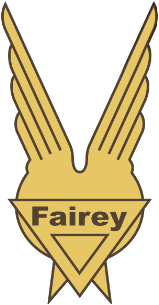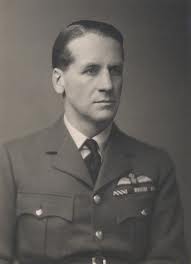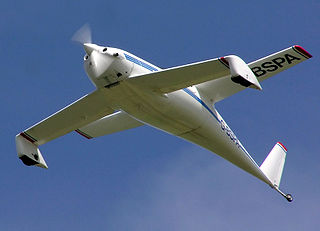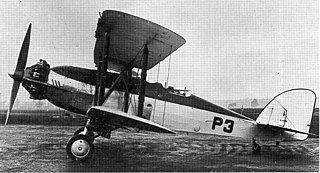Related Research Articles

A tiltrotor is an aircraft that generates lift and propulsion by way of one or more powered rotors mounted on rotating shafts or nacelles usually at the ends of a fixed wing. Almost all tiltrotors use a transverse rotor design, with a few exceptions that use other multirotor layouts.

The Bristol Pegasus is a British nine-cylinder, single-row, air-cooled radial aero engine. Designed by Roy Fedden of the Bristol Aeroplane Company, it was used to power both civil and military aircraft of the 1930s and 1940s. Developed from the earlier Mercury and Jupiter engines, later variants could produce 1,000 horsepower from its capacity of 1,750 cubic inches by use of a geared supercharger.

The Fairey Aviation Company Limited was a British aircraft manufacturer of the first half of the 20th century based in Hayes in Middlesex and Heaton Chapel and RAF Ringway in Cheshire that designed important military aircraft, including the Fairey III family, the Swordfish, Firefly, and Gannet. It had a strong presence in the supply of naval aircraft, and also built bombers for the RAF.

The Westland Lysander is a British army co-operation and liaison aircraft produced by Westland Aircraft that was used immediately before and during the Second World War.

Air Commodore Douglas Douglas-Hamilton, 14th Duke of Hamilton and 11th Duke of Brandon, was a Scottish nobleman and aviator who was the first man to fly over Mount Everest.

A tandem wing is a wing configuration in which a flying craft or animal has two or more sets of wings set one behind another. All the wings contribute to lift.

The Westland Wapiti was a British two-seat general-purpose military single-engined biplane of the 1920s. It was designed and built by Westland Aircraft Works to replace the Airco DH.9A in Royal Air Force service.

The Westland Wallace was a British two-seat, general-purpose biplane of the Royal Air Force, developed by Westland as a follow-on to their successful Wapiti. As the last of the interwar general purpose biplanes, it was used by a number of frontline and Auxiliary Air Force Squadrons. Although the pace of aeronautical development caused its rapid replacement in frontline service, its useful life was extended into the Second World War with many being converted into target tugs and wireless trainers. In 1933 a Westland Wallace became the first aircraft to fly over Everest, as part of the Houston-Mount Everest Flight Expedition.

The Westland PV-3 was a British two-seat torpedo bomber of the 1930s built by Westland Aircraft Works. The aircraft was a private venture development and based on the Westland Wapiti. It never entered production. The aircraft is best known as one of the first two to fly over Everest as part of the Houston-Mount Everest Flight Expedition.

The Avro 534 Baby was a British single-seat light sporting biplane built shortly after the First World War.

The wing configuration of a fixed-wing aircraft is its arrangement of lifting and related surfaces.
The Port Victoria P.V.7 Grain Kitten was a prototype British Fighter aircraft of the First World War designed and built by the Port Victoria Marine Experimental Aircraft Depot on the Isle of Grain. A very small and light biplane intended to fly off platforms on Royal Navy Destroyers, it was unsuccessful, only a single prototype being built.

The Vickers Type 253 was a single-engined two-seat biplane general-purpose military machine built to a 1930 government specification. It won a production contract, but this was transferred to the same company's monoplane equivalent, the Wellesley. Only one Type 253 was built.
The Westland PV.7 was a private venture submission to a 1930s British specification for a general-purpose military aircraft with two crew. It was a single-engined, high-wing monoplane of promise, but was destroyed early in official tests.

The Short S.27 and its derivative, the Short Improved S.27, were a series of early British aircraft built by Short Brothers. They were used by the Admiralty and Naval Wing of the Royal Flying Corps for training the Royal Navy's first pilots as well as for early naval aviation experiments. An Improved S.27 was used by C.R. Samson to make the first successful take-off from a moving ship on 9 May 1912.
The Short S.80 was an early British floatplane built by Short Brothers for Frank McClean to undertake an aerial expedition up the Nile to investigate the cataracts between Aswan and Khartoum. After a successful flight to Khartoum it was returned to England, where it was used for training by the RNAS. When built it was the largest successful aircraft that had been constructed in Britain. It was also known as the Short Nile Pusher Biplane Seaplane.
Harald James Penrose, O.B.E, CEng, F.R.Ae.S, A.M.I.N.A was the chief test pilot at Westland Aircraft between 1931 and 1953, a naval architect, and an aviation author. His flying experience ranged from man carrying kites before the First World War to early jet fighters and helicopters. He designed, built and flew his own glider in the 1930s, designed 36 boats and yachts, and wrote many books describing his flying career and the history of British aviation.

The first flight over Mount Everest was undertaken in April 1933 by two Westland aircraft. They were piloted by Douglas Douglas-Hamilton and David McIntyre, with Stewart Blacker and Sidney Bonnett in the observer seats. The expedition was financed by Lucy, Lady Houston.
References
- ↑ "The 8th Academy Awards (1936) Nominees and Winners". oscars.org. Archived from the original on 6 July 2011. Retrieved 7 August 2011.
- ↑ Meredith-Hardy, Richard (31 January 2004). "Over Everest: Aeroplane Expeditions to Everest". flymicro.com. Retrieved 12 October 2013.
- ↑ "81 years ago, the first movie camera over Everest won an Oscar". 26 May 2017. Retrieved 27 May 2017.
- 1 2 3 4 Arbuckle, Alex (October 2016). "The first men to fly over Mount Everest did so in an unpressurized biplane". Mashable. Retrieved 27 May 2017.
- ↑ "Remembering the Scots who flew over Everest some 80 years ago". www.scotsman.com. Retrieved 27 May 2017.
- ↑ "Remembering the Scots who flew over Everest some 80 years ago". www.scotsman.com. Retrieved 24 January 2019.
- ↑ "Preserved Projects". Academy Film Archive. Retrieved 18 April 2020.
